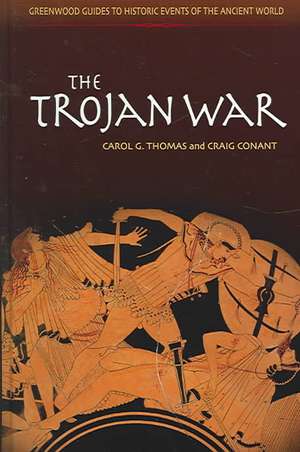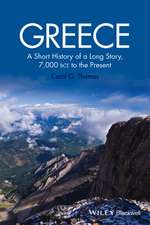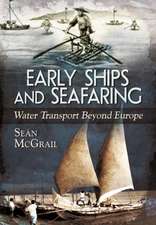The Trojan War: Greenwood Guides to Historic Events of the Ancient World
Autor Craig C. Conant, Carol G. Thomasen Limba Engleză Hardback – 29 ian 2005 – vârsta până la 17 ani
Preț: 222.81 lei
Preț vechi: 383.61 lei
-42% Nou
Puncte Express: 334
Preț estimativ în valută:
42.64€ • 45.59$ • 35.55£
42.64€ • 45.59$ • 35.55£
Carte tipărită la comandă
Livrare economică 17 aprilie-01 mai
Preluare comenzi: 021 569.72.76
Specificații
ISBN-13: 9780313325267
ISBN-10: 031332526X
Pagini: 240
Ilustrații: 1, black & white illustrations
Dimensiuni: 156 x 235 x 22 mm
Greutate: 0.5 kg
Ediția:New.
Editura: Bloomsbury Publishing
Colecția Greenwood
Seria Greenwood Guides to Historic Events of the Ancient World
Locul publicării:New York, United States
ISBN-10: 031332526X
Pagini: 240
Ilustrații: 1, black & white illustrations
Dimensiuni: 156 x 235 x 22 mm
Greutate: 0.5 kg
Ediția:New.
Editura: Bloomsbury Publishing
Colecția Greenwood
Seria Greenwood Guides to Historic Events of the Ancient World
Locul publicării:New York, United States
Notă biografică
Carol G. Thomas is Professor of History at the University of Washington and the author or co-author of Citadel to City-State: The Transformation of Greece, 1200-700 BCE (with Craig Conant), Makedonika, Classical Greece, and Progress into the Past: The Rediscovery of Mycenaean Civilization.Craig Conant is the co-author of From Citadel to City-State (with Carol G. Thomas).
Cuprins
Series ForewordAuthor's PrefaceTimelineThe Trojan War in History and LegendTroy and the World of the Late Bronze AgeFinding Troy and the Trojan WarHomer and the Epic TraditionThe Force of LegendTroy in the Twenty-First CenturyBiographical SketchesReadings From Primary Documents and Other SourcesGlossary of Selected TermsAnnotated BibliographyIndex
Recenzii
Recommended. Lower-division undergraduates and two-year technical program students; general readers
Was it Iphigeneia or Penthesileia whom Achilles slew in battle? Is Memnon just a nickname for Agamemnon? And how did all those Hittites get in there? For those of us who have trouble telling Antenor from Andromache, Thomas and co-author Conant sort out the events and characters of Homer's account, and give us the background to appreciate his themes. They describe the contexts of the late Bronze Age, the efforts by scholars to find what turned out to be the real Troy, the influence of Homer in the epic tradition, the force of legend, and the implications of the story of Troy for the present day. They include a photo essay, a chronology, compilations of biographies of characters and original documents, a glossary, and an annotated bibliography.
This is an accessible book, admirably suited to its target readship. A copy in a school or departmental library would provide an excellent introduction to the nature of oral epic and to the problems (with some possible solutions) of identifying places, events and characters in Homeric epic, and a valuable resource for students researching coursework.
This guide provides an in-depth discussion of the ancient civilizations of the Aegean. The main focus is to explain plausible evidence that supports the growing body of scholarship, which holds that Troy and the Trojan War existed not only in oral tradition, but also in fact..Although this guide will certainly not be light fare for the casual reader, those studying the ancient and classical worlds, will not be disappoined. Recommended.
Was it Iphigeneia or Penthesileia whom Achilles slew in battle? Is Memnon just a nickname for Agamemnon? And how did all those Hittites get in there? For those of us who have trouble telling Antenor from Andromache, Thomas and co-author Conant sort out the events and characters of Homer's account, and give us the background to appreciate his themes. They describe the contexts of the late Bronze Age, the efforts by scholars to find what turned out to be the real Troy, the influence of Homer in the epic tradition, the force of legend, and the implications of the story of Troy for the present day. They include a photo essay, a chronology, compilations of biographies of characters and original documents, a glossary, and an annotated bibliography.
This is an accessible book, admirably suited to its target readship. A copy in a school or departmental library would provide an excellent introduction to the nature of oral epic and to the problems (with some possible solutions) of identifying places, events and characters in Homeric epic, and a valuable resource for students researching coursework.
This guide provides an in-depth discussion of the ancient civilizations of the Aegean. The main focus is to explain plausible evidence that supports the growing body of scholarship, which holds that Troy and the Trojan War existed not only in oral tradition, but also in fact..Although this guide will certainly not be light fare for the casual reader, those studying the ancient and classical worlds, will not be disappoined. Recommended.

















